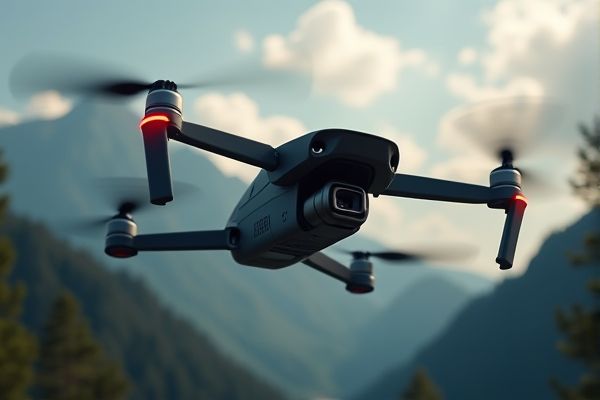
AI enhances drone technology by enabling advanced navigation and obstacle avoidance capabilities, allowing drones to operate safely in complex environments. Machine learning algorithms analyze vast amounts of data collected during flights, improving decision-making processes and flight efficiency. Computer vision, powered by AI, allows drones to identify and classify objects, making them ideal for applications like agricultural monitoring and search-and-rescue missions. Integration of AI also facilitates autonomous operations, enabling drones to perform tasks without constant human oversight, saving time and resources.
AI usage in drone technology
Autonomous Navigation Systems
AI enhances drone technology by improving autonomous navigation systems, allowing for precise mapping and obstacle avoidance. These systems can analyze environmental data in real time, increasing safety and efficiency during flights. For instance, companies like Zipline utilize AI to optimize delivery routes for medical supplies in remote areas. The integration of AI could lead to advancements in surveillance, agriculture, and disaster response applications.
Real-time Data Processing
AI integration in drone technology enhances real-time data processing capabilities, allowing for immediate analysis and decision-making. This advancement can improve various applications, such as agricultural monitoring, where drones equipped with AI can assess crop health efficiently. The precision provided by AI algorithms may lead to better resource management and increased yield. As these technologies evolve, institutions like NASA are exploring their potential to optimize aerial missions and data collection.
Obstacle Detection and Avoidance
AI enhances drone technology by improving obstacle detection and avoidance capabilities. Utilizing machine learning algorithms, drones can analyze their surroundings in real-time, identifying potential hazards more effectively. For example, the integration of computer vision enables drones to navigate complex environments autonomously. This advancement offers a significant advantage for applications in delivery services and aerial mapping.
Precision Mapping and Surveying
AI integration in drone technology enhances precision mapping and surveying by automating data collection and analysis. Companies like DJI are incorporating AI algorithms to improve flight planning and obstacle avoidance. This advancement allows for more accurate terrain representation and efficient resource management. The potential for increased productivity and reduced human error makes AI-driven drones advantageous in fields such as agriculture and construction.
Image Recognition and Classification
AI integration in drone technology enhances image recognition and classification capabilities, allowing for more accurate data analysis. For instance, agricultural drones utilize AI to identify crop health and optimize yield. These advancements can provide significant advantages in various sectors, including environmental monitoring and disaster response. The potential for improved decision-making processes increases as these technologies evolve and become more accessible.
Flight Path Optimization
AI can enhance flight path optimization for drones by analyzing terrain and environmental data in real time. This technology has the potential to reduce fuel consumption and improve delivery efficiency for companies like Amazon. By leveraging machine learning algorithms, drones can adapt their routes, avoiding obstacles while minimizing travel time. The implementation of such AI solutions could lead to significant cost savings and increased operational effectiveness in various industries.
Swarm Drone Coordination
AI enhances drone technology by enabling swarm drone coordination, allowing multiple drones to operate collaboratively in various applications. This capability can significantly improve efficiency in tasks such as agricultural monitoring or disaster response. The integration of AI algorithms facilitates real-time communication and decision-making among drones, enhancing their ability to adapt to changing environments. As an example, companies like Zipline utilize swarm coordination for real-time medical supply delivery, showcasing the potential advantages in logistics and emergency services.
Environmental Monitoring
AI integration in drone technology can enhance environmental monitoring by improving data collection accuracy and efficiency. For instance, drones equipped with AI algorithms can analyze satellite imagery to identify changes in land use or deforestation patterns. The chance of timely interventions is increased as AI can process vast amounts of environmental data in real-time. Organizations like NASA utilize such technology to monitor climate changes and assess natural resource management.
Payload Delivery Accuracy
AI enhances drone technology by improving payload delivery accuracy through advanced algorithms. By utilizing real-time data analytics, drones can assess environmental conditions, optimizing flight paths for better efficiency. An example includes a logistics company integrating AI to reduce delivery errors and increase customer satisfaction. The incorporation of AI opens up possibilities for enhanced precision in various industries, such as medical supply deliveries.
Predictive Maintenance Systems
The integration of AI in drone technology enhances operational efficiency by enabling real-time data analysis. Predictive maintenance systems, for instance, utilize AI algorithms to forecast potential equipment failures, reducing downtime. This capability allows companies in various sectors, such as agriculture or logistics, to optimize resource allocation. The possibility of increasing safety and reducing costs is a significant advantage that organizations can leverage through these technologies.
 techknowy.com
techknowy.com